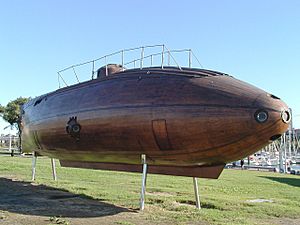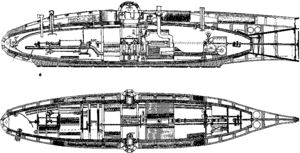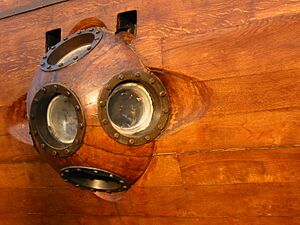Ictíneo II facts for kids
class="infobox " style="float: right; clear: right; width: 315px; border-spacing: 2px; text-align: left; font-size: 90%;"
| colspan="2" style="text-align: center; font-size: 90%; line-height: 1.5em;" | 
|} The Ictíneo II was a very important and early submarine. It was launched in Barcelona, Spain, on October 2, 1864. A Spanish engineer named Narcis Monturiol built it. This submarine was special because it was the first to use an engine that didn't need outside air. It was also the first to use a combustion engine underwater. This helped solve big problems with making submarines move well underwater.
Contents
- Building the Ictíneo II
- First Journeys and New Ideas
- Hopes for the Submarine
- Steam Power and Final Days
- How the Ictíneo II Was Built
- See also
Building the Ictíneo II
The Ictíneo II was meant to be a better version of the Ictíneo I. The first Ictíneo was powered by hand. The Spanish Navy said they would help Monturiol, but they didn't give him any money.
So, Monturiol had to find money himself. He wrote a special letter to the nation. This letter asked people in Spain to donate money. Many citizens helped, and they raised a lot of money. This money was used to start a company called La Navegación Submarina. This company was created to build the Ictíneo II.
First Journeys and New Ideas
The Ictíneo II had its first trip on May 20, 1865. At first, it was still powered by people. It went underwater to about 27.5 metres (90 ft) deep.
Monturiol learned about submarines being built during the American Civil War. He was having money problems, so he wrote to the US Secretary of the Navy. But by the time the Secretary replied, the war was over.
Monturiol wasn't happy with how slow human power was. He realized the submarine needed a steam engine. But normal steam engines needed a fire, which was too dangerous underwater. So, he invented a special engine that didn't need air from outside. This engine used a chemical reaction to make its own oxygen for burning fuel.
Hopes for the Submarine
Monturiol hoped to use the submarine for business. He wanted it to help collect coral reefs underwater. He also put a gun inside the submarine. From December 22 to December 30, 1865, he did tests. He fired the gun underwater at targets. But the military leaders were not impressed.
Monturiol wanted to build a new submarine just for his special engine. This new submarine would be made completely of metal. The engine would be in its own separate part. But he didn't have enough money for a brand new ship. Instead, he managed to get enough money to put the new engine into the Ictíneo II.
Steam Power and Final Days
On October 22, 1867, the Ictíneo II traveled on the surface using steam power for the first time. It went about 3.5 knots (6.5 km/h) on average. Its fastest speed was 4.5 knots (8.3 km/h). Two months later, on December 14, Monturiol made the submarine go underwater. He used his chemical engine, but it was quite slow, only 2.5 knots (4.6 km/h). The submarine could dive up to 27.5 metres (90 ft) deep. It could stay underwater for seven and a half hours.
Plan of Ictíneo II
On December 23, the company La Navegación Submarina ran out of money and went bankrupt. Monturiol had spent a huge amount of money. He couldn't find any more investors. The person he owed the most money to demanded payment. Monturiol had to give up the Ictíneo II, which was all he had left.
The person who got the submarine then sold it to a businessman. But the government taxed all ships. So, they sent the new owner a tax bill. Instead of paying the tax, the businessman took the submarine apart. He sold it for scrap metal. The engine that worked on the surface went to a textile factory. The windows from the submarine ended up as bathroom windows.
How the Ictíneo II Was Built
A close-up of the Ictíneo IIreplica in Barcelonaharbour.
The Ictíneo II was about 14 metres (46 ft) long. It was 2 metres (6.6 ft) wide and 3 metres (9.8 ft) high. It weighed 46 tonnes. The inside space was 29 cubic metres (1,000 cu ft). It was built from olive wood. Strong oak wood was used to make it even stronger. It also had a thin layer of copper, about 2 mm thick, on its outside.
The top of the submarine had a deck that was 1.3 metres (4.3 ft) wide. There was a hatch with three round windows. These windows were 200 mm (7.9 in) across and made of thick glass, 100 mm (3.9 in) thick. The submarine could be steered from the conning tower using a special gear.
The submarine had four tanks, each holding 8 cubic metres (280 cu ft) of water. These were called ballast tanks. They were placed evenly on both sides, in the spaces between the outer and inner parts of the submarine. To make the submarine dive, these tanks would fill with water. To make it surface, air would be pumped into the tanks to push the water out.
A special weight could be moved back and forth along a rail. This helped control how the submarine tilted when it was diving. The helmsman could control this weight from inside. The submarine also had an emergency system. This system could quickly drop the ballast (the heavy parts) to make the submarine surface fast if needed.
The most important new idea in the Ictíneo II was its special engine for underwater travel. This engine didn't need air from outside. It used a chemical reaction of zinc, manganese dioxide, and potassium chlorate. This reaction heated a boiler for a steam engine. This provided power for moving the submarine and for lights. The reaction also released oxygen, which the crew could breathe.
Monturiol bought a six-cylinder steam engine. He split it in half. One half was powered by a coal-burning boiler for when the submarine was on the surface. The other half was powered by a separate boiler. This second boiler was heated by his special chemical mixture for underwater use.
See also
- Ictineu 3
- V-80 submarine
| Class overview | |
|---|---|
| Name: | Ictíneo II |
| Builders: | La Navegación Submarina, |
| Operators: | Narciso Monturiol |
| Preceded by: | Ictíneo I |
| In service: | 20 May 1865 to Dec 1867 |
| Completed: | 1 |
| Retired: | 1 |
| General characteristics | |
| Class and type | Submarine |
| Tonnage | 46 t (45 long tons; 51 short tons) |
| Length | 14 m (45 ft 11 in) (light hull) |
| Beam | 2 m (6 ft 7 in) (light hull) |
| Height | 3 m (9 ft 10 in) (light hull) |
| Installed power | Air independent steam engine submerged; coal powered steam engine surfaced |
| Propulsion | Screw propeller |
| Speed | 4.5 knots surfaced |
| Endurance | Tested to 7 hours submerged |
| Test depth | 30 m (98 ft) |



